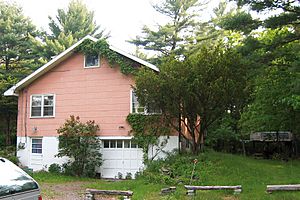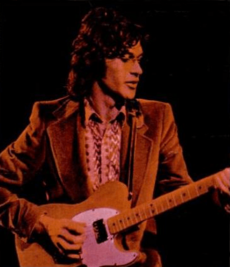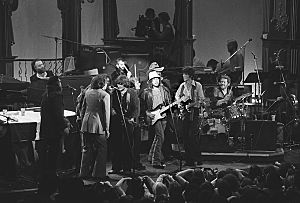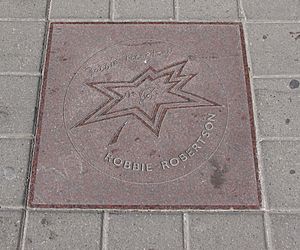Robbie Robertson facts for kids
Quick facts for kids
Robbie Robertson
|
|
|---|---|
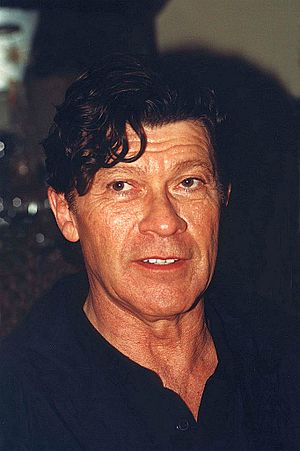
Robertson in 2001
|
|
| Background information | |
| Birth name | Jaime Royal Robertson |
| Born | July 5, 1943 Toronto, Ontario, Canada |
| Died | August 9, 2023 (aged 80) Los Angeles, California, U.S. |
| Genres |
|
| Occupation(s) |
|
| Instruments |
|
| Years active | 1957–2023 |
| Labels | |
Jaime Royal "Robbie" Robertson OC (July 5, 1943 – August 9, 2023) was a famous Canadian musician. He was best known as the lead guitarist for Bob Dylan in the 1960s and 1970s. He was also a key guitarist and songwriter for the Band until 1978. Later, he had a successful career as a solo artist.
Robbie Robertson's music with the Band helped create the Americana music style. He was honored in the Rock and Roll Hall of Fame and the Canadian Music Hall of Fame as a member of the Band. He also has a star on Canada's Walk of Fame, both with the Band and on his own. Rolling Stone magazine ranked him 59th among the 100 greatest guitarists. As a songwriter, he wrote hits like "The Weight", "The Night They Drove Old Dixie Down", and "Up on Cripple Creek" for the Band. His solo hits included "Broken Arrow" and "Somewhere Down the Crazy River". He was inducted into the Canadian Songwriters Hall of Fame. He also received a Lifetime Achievement Award for his songwriting.
Beyond music, Robertson was a film soundtrack producer and composer. He worked closely with director Martin Scorsese. Their partnership began with the music film The Last Waltz (1978). They continued to work together on many movies, including Raging Bull (1980), Casino (1995), and Killers of the Flower Moon (2023). He also worked on many other soundtracks for movies and TV shows.
Contents
- Robbie Robertson's Early Life
- Robbie Robertson's Music Career
- Robbie Robertson's Solo Career
- Later Career Highlights
- Honors and Awards
- As an Author
- Personal Life
- Discography
- Filmography
- Images for kids
- See also
Robbie Robertson's Early Life
Robbie Robertson was born Jaime Royal Robertson on July 5, 1943. He was an only child. His mother, Rosemarie Dolly Chrysler, was from the Cayuga and Mohawk nations. She grew up on the Six Nations Reserve near Toronto, Ontario.
Robbie often visited his mother's family on the Six Nations Reserve. There, his older cousin Herb Myke taught him how to play the guitar. He loved rock 'n' roll and R&B music. He listened to these styles on the radio late at night.
When Robbie was a teenager, his parents separated. His mother told him that his biological father was Alexander David Klegerman. He was a Jewish man who passed away in an accident. After this, Robbie met his paternal uncles.
Robbie Robertson's Music Career
When Robbie was 14, he worked briefly at a travelling carnival. He later used these experiences for his song "Life is a Carnival" (with the Band) and the movie Carny (1980). He produced and starred in the movie.
His first band was Little Caesar and the Consuls in 1956. He played popular songs at teen dances. In 1957, he formed Robbie and the Rhythm Chords. They later changed their name to Robbie and the Robots. They even customized Robbie's guitar to look like it was from space!
Playing with Ronnie Hawkins
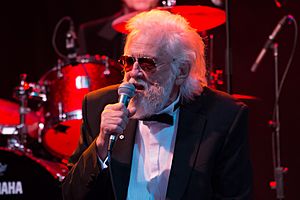
Robbie Robertson soon started working with Ronnie Hawkins. Hawkins was an Arkansas rockabilly musician. Robertson joined Hawkins' backup band, the Hawks, as a road crew member. Hawkins recorded two songs that Robertson helped write.
Hawkins then hired Robertson to play bass in the Hawks. A few months later, Robbie switched to lead guitar. He became a very skilled guitar player. Roy Buchanan, another guitarist, greatly influenced Robertson's style.
Drummer Levon Helm was already in the Hawks. He and Robertson became close friends. The Hawks toured the United States and Canada. In 1961, Rick Danko, Richard Manuel, and Garth Hudson joined the band. This lineup later became the Band. They toured with Hawkins until 1963.
Levon and the Hawks
In early 1964, the Hawks left Ronnie Hawkins. They wanted to play more blues and soul music instead of rockabilly. They started performing on their own. At first, they were called The Levon Helm Sextet. Later, they changed their name to Levon and the Hawks.
The group became friends with blues artist John P. Hammond. They played on Hammond's album So Many Roads in 1965. Robertson played guitar on the album.
Levon and the Hawks released a single called "Uh Uh Uh" in 1965. Robertson wrote both songs on the single. They also released two more singles later that year. Robertson wrote all the songs for these singles too.
Working with Bob Dylan
World Tour 1965–1966
In August 1965, Bob Dylan's manager asked Robbie Robertson to meet Dylan. Dylan wanted Robertson to play guitar in his band. Robertson said no to being just a guitarist. But he agreed to play two shows with Dylan. He also suggested that Levon Helm play drums.
Robertson and Helm played with Dylan's band at these shows. The first show was not well received by fans. Many fans were upset that Dylan, a folk singer, was now playing rock music. Dylan then hired the full Levon and the Hawks band for his upcoming tour.
Bob Dylan and the Hawks toured the United States from October to December 1965. Each show had two parts: an acoustic set by Dylan alone, and an electric set with the Hawks. Fans often reacted negatively to the electric set. Levon Helm left the group during this tour. Other drummers filled in.
The tour continued in 1966, going to Hawaii, Australia, Europe, and the UK. The European shows were especially tough, with many folk fans booing Dylan. A famous moment was when an audience member yelled "Judas!" at Dylan during a show in Manchester. This concert was later officially released as The Bootleg Series Vol. 4: Bob Dylan Live 1966, The "Royal Albert Hall" Concert.
A documentary filmmaker filmed the European tour. Dylan later edited it himself. The film, Eat the Document, was shown in 1972.
"Basement Tapes" Period
In July 1966, Bob Dylan had a motorcycle accident. He decided to rest at home in upstate New York. In February 1967, Dylan invited the Hawks to work on music with him in Woodstock, New York. Robertson and his wife moved to the Woodstock area. The other Hawks members rented a house nearby. This house was called "Big Pink" because of its pink color.
Dylan and the Hawks worked together every day at Big Pink. They rehearsed and created new songs. They recorded many of these songs in a makeshift studio in Big Pink's basement. Levon Helm rejoined the group in August 1967. By this time, Robertson's guitar playing focused more on supporting the song.
News of these recordings spread. In 1968, Rolling Stone magazine wrote about them. In 1969, a collection of these songs was released as a bootleg album. This album, The Great White Wonder, became very popular. It helped start the bootleg recording industry.
In 1975, Robertson produced an official album of these songs called The Basement Tapes. A complete collection of all 138 recordings was released in 2014.
With the Band
Music From Big Pink (1967–1968)
In late 1967, Bob Dylan recorded his next album. He asked Robertson and Garth Hudson to play on it. But Robertson liked the simple sound of Dylan's recordings. He suggested Dylan leave them as they were. Dylan and the Hawks played together again in January 1968. They performed at two concerts honoring Woody Guthrie.
The group had developed their own unique sound. They signed a contract with Capitol Records. They recorded their first album, Music From Big Pink, which was released in August 1968.
Robertson wrote four songs on Music From Big Pink. These included "The Weight" and "Chest Fever". "The Weight" was inspired by films about people trying to be good. It became the Band's most famous song. Many artists have covered it, and it has appeared in many movies.
When Music from Big Pink was released, the Band avoided media attention. They did not tour much or give interviews. This created a mystery around the group. The album received excellent reviews. It influenced many famous musicians.
The Band (1969)
In early 1969, the Band rented a house in Hollywood Hills. They turned the pool house into a studio. They wanted to create a comfortable "clubhouse" feeling like they had at Big Pink. They recorded every day to finish their next album. Robertson did most of the sound engineering.
The Band started performing live regularly in spring 1969. They played at the Winterland Ballroom in San Francisco. Their most famous shows that year were at the 1969 Woodstock Festival. They also played at the UK Isle of Wight Festival with Bob Dylan.
The Band's album The Band was released in September 1969. It was a big success with critics and fans. It reached #9 on the US pop charts. The album explored American themes. It was important in creating the Americana music style.
"The Night They Drove Old Dixie Down" was a very influential song from this album. It tells the story of a Confederate man's life after the American Civil War. A cover version by Joan Baez became a #3 hit in 1971.
Other songs from The Band also became popular. "Up on Cripple Creek" was their only Top 30 hit in the US. "Rag Mama Rag" reached #16 in the UK. The Band appeared on the Ed Sullivan Show in November 1969.
Later Albums (1970–1973)
In January 1970, the Band was featured on the cover of Time magazine. This was the first time a North American rock band had this honor.
The Band recorded their third album, Stage Fright, in two weeks. Robertson wrote most of the songs. This album became the Band's highest-charting album, reaching #5.
Their next album, Cahoots, was released in October 1971. It included a cover of Bob Dylan's "When I Paint My Masterpiece". It also featured the popular song "Life Is a Carnival".
The Band continued to tour in 1970-71. A live album, Rock Of Ages, was released in 1972. It reached #6 on the charts.
After a break from live shows, the Band played at the Summer Jam at Watkins Glen in July 1973. They performed with the Allman Brothers Band and the Grateful Dead. Over 600,000 people attended, setting a world record for pop festival attendance.
In October 1973, the Band released Moondog Matinee, an album of cover songs.
Reunion with Bob Dylan (1974)
In 1973, Bob Dylan and Robbie Robertson both moved to Malibu, California. The rest of the Band members soon followed.
David Geffen arranged a tour for Bob Dylan and the Band. It was Dylan's first tour in over seven years. The demand for tickets was huge, with millions of requests for seats.
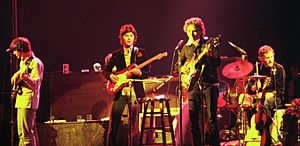
Before the tour, the Band recorded a new album with Bob Dylan. This album, Planet Waves (1974), was Dylan's first #1 album. It was the only studio album they recorded together.
The 1974 tour began in January. The shows started with new songs. But as the tour went on, they played more familiar older songs. This time, audiences loved the electric performances that had caused mixed reactions years before.
The last three shows of the tour were recorded. They were released as the double album Before the Flood. This album reached #3 on the charts.
Shangri-La Studios and New Music (1974–1975)
After the 1974 tour, Robertson and the Band found a ranch in Malibu called "Shangri-La." They leased it and turned the main house into a recording studio.
The first album recorded at Shangri-La Studios was The Basement Tapes. Robertson produced this album. It included songs from the original 1967 sessions with Dylan.
In spring 1975, the Band began working on Northern Lights – Southern Cross. This was their first album of new songs in four years. One famous song from the album is "Acadian Driftwood". It was the first song with Canadian themes. Robertson was inspired to write it after seeing a documentary about Acadian history. Other notable songs were "It Makes No Difference" and "Ophelia".
Northern Lights – Southern Cross was released in November 1975. It received good reviews and reached #26 on the charts.
The Last Waltz Concert (1976)
The Band started touring again in June 1976. But the members were also working on their own projects. Richard Manuel, a Band member, was in a boating accident. Ten tour dates were cancelled.
During this time, Robertson suggested that the Band stop touring. He said they should have one final "grand finale" show. Then, they could work on solo projects and regroup later. Levon Helm later said that Robertson forced the Band's breakup.
Concert promoter Bill Graham booked the Band for a show at the Winterland Ballroom on Thanksgiving Day, November 25, 1976. This event was planned as a big gala. It included a Thanksgiving dinner for the audience. The Band would perform with many famous musical guests. These guests included Ronnie Hawkins, Muddy Waters, Bob Dylan, Eric Clapton, Joni Mitchell, and Neil Young.
Robertson wanted to film the concert. He asked director Martin Scorsese to shoot it. The concert was called The Last Waltz. Robertson and Scorsese planned the show in great detail. They listed every song, singer, and instrument. They also planned the camera and lighting work.
Scorsese brought in top cameramen to film the show. John Simon, who produced the Band's first two albums, helped with rehearsals. Robertson produced the film.
Rehearsals for The Last Waltz began in early November. The Band also recorded a new studio album, Islands, for Capitol Records. Robertson wrote or co-wrote most of the songs. One song, "Knockin' Lost John," featured Robertson singing lead vocals. "Christmas Must Be Tonight" was inspired by the birth of his son, Sebastian.
The Last Waltz concert took place on Thanksgiving Day, November 25, 1976. About five thousand people attended. The event began with a traditional Thanksgiving meal. Then, the Band played songs. After that, many guest stars joined them on stage.
After a break, the Band returned. They played a new song called "The Last Waltz Theme." Bob Dylan joined them at the end of this set. All the guest stars then performed "I Shall Be Released" together. The show ended with two all-star jam sessions. The Band closed the night with "Baby Don't You Do It".
The Last Waltz Film and Album (1977–1978)
After the concert, director Martin Scorsese had a lot of film footage. He started editing it. Robertson and Scorsese continued to develop ideas for the film. In April 1977, they filmed Emmylou Harris and the Staple Singers performing with the Band. Harris sang on "Evangeline," a new song by Robertson. The Staple Singers recorded a new version of "The Weight."
Scorsese also interviewed the Band members for the film. These interviews helped tell their story.
The Last Waltz album was released on April 7, 1978. It was a three-record set. The first five sides had live performances from the concert. The last side had studio recordings. The album reached #16 on the charts.
The Last Waltz film was released in theaters on April 26, 1978. It was well-received by critics. Robertson and Scorsese promoted the film across America and Europe. Over time, The Last Waltz became known as an important and groundbreaking rockumentary. It influenced many music films that followed.
Film Career (1980–2023)
After The Last Waltz, Robbie Robertson was seen as a potential film actor. He was given an office at MGM. He was interested in making a film about traveling carnivals. This was because of his own childhood experiences. The film Carny was directed by Robert Kaylor.
Robertson was supposed to be only the producer of Carny. But he ended up playing a main role as Patch. Gary Busey and Jodie Foster also starred in the film. Carny opened in theaters on June 13, 1980. A soundtrack album for Carny was also released.
Working with Martin Scorsese
Robertson and Martin Scorsese had a long working relationship. Robertson would find or create music for Scorsese's films. He said, "He's a frustrated musician, and I guess I was a frustrated filmmaker. So it was a perfect connect."
Their first collaboration was on the film Raging Bull (1980). Robertson found and produced three new instrumental jazz songs for the film. He also helped Scorsese choose the film's opening music.
Robertson worked with Scorsese again on The King of Comedy (1983). He contributed an original song called "Between Trains" to the soundtrack. He sang and played guitar and keyboards on the song.
In 1986, Robertson started working on Scorsese's film The Color of Money. He found music for the film and also composed the film's score. This was the first time he wrote dramatic music for a movie. He brought in jazz composer Gil Evans to help.
A well-known song from The Color of Money soundtrack is Eric Clapton's "It's in the Way That You Use It". Robertson co-wrote this song. It reached #1 on the Billboard Mainstream Rock Songs chart.
Robertson continued to work on Scorsese's films. These included Casino, The Departed, The Wolf of Wall Street, The Irishman, and Killers of the Flower Moon. He worked on these films until shortly before his death.
Robbie Robertson's Solo Career
Geffen Records Albums
Robbie Robertson (1987)
Robertson began his first solo album, Robbie Robertson, in July 1986. He signed with Geffen Records. He chose Canadian producer Daniel Lanois to help. He recorded the album in Los Angeles, New York, Dublin, and Bath. Many guest artists appeared on the album, including U2 and Peter Gabriel. Garth Hudson and Rick Danko from the Band also played on it. Robertson wrote "Fallen Angel" to honor Richard Manuel, who had passed away.
The album was released on October 26, 1987. It reached #35 on the Billboard 200 chart in the US. It did even better in the UK, reaching #23. Critics praised Robbie Robertson. It was listed among the top albums of the year by many critics.
Robertson's biggest hit in the UK was "Somewhere Down The Crazy River." This song featured his spoken words mixed with singing. It reached #15 on the UK charts. Martin Scorsese directed the music video for the song.
In the US, "Showdown At Big Sky" and "Sweet Fire Of Love" were hits from the album. The album was nominated for a Grammy Award. It was certified gold in the United States. In Canada, Robertson won Album Of The Year and Producer Of The Year at the Juno Awards in 1989.
In 1991, Rod Stewart recorded "Broken Arrow." Stewart's version became a hit in the US and Canada. The Grateful Dead also performed "Broken Arrow" live.
Storyville (1991)
Storyville was released on September 30, 1991. Robertson went to New Orleans to work with local musicians like Aaron Neville and the Rebirth Brass Band. Garth Hudson and Rick Danko also contributed to the album. The album reached #69 on the Billboard 200 chart.
Storyville received many positive reviews. Two songs from the album, "What About Now" and "Go Back To Your Woods," were popular on rock radio. The album was nominated for two Grammy awards.
Later Solo Albums
Music for the Native Americans (1994): In 1994, Robertson explored his Native American heritage. He formed a group called the Red Road Ensemble. They created Music for the Native Americans. This album was for a TV documentary series. Songs like "Ghost Dance" talked about historical events, connecting to his family's history. Robertson won a Juno Award for Producer of the Year. The song "Mahk Jchi (Heartbeat Drum Song)" became an international success.
Contact from the Underworld of Redboy (1998): On Contact from the Underworld of Redboy, Robertson mixed rock, native, and electronic music. He worked with producers like Howie B and DJ Premier. The album explored native traditions. The title of the album came from a childhood experience where bullies called him "Red Boy." Rolling Stone gave the album 4 out of 5 stars. Robertson won a Juno Award for Best Music of Aboriginal Canada Recording.
How to Become Clairvoyant (2011): Released on April 5, 2011, How to Become Clairvoyant was Robertson's fifth solo album. It started from jam sessions with his friend Eric Clapton. The album featured many guest artists, including Eric Clapton, Steve Winwood, and Trent Reznor. Robertson performed songs from the album on TV shows like Late Show with David Letterman.
This album was his highest-charting solo work, reaching #13 on the Billboard 200. He also worked with artist Richard Prince to create a special limited edition of the album.
Sinematic (2019): Sinematic was Robertson's sixth solo album, released on September 20, 2019. It featured Van Morrison on the song “I Hear You Paint Houses." The album also had other references to Martin Scorsese's films. Derek Trucks and Frédéric Yonnet made guest appearances.
Later Career Highlights
Robertson continued to work on Martin Scorsese's movies. He provided music for Casino, The Departed, and The Wolf of Wall Street. In 1995, he headlined a concert festival in Rome with artists like Andrea Bocelli and Radiohead.
In 1996, Robertson suggested the song "Change the World" to Eric Clapton for the movie Phenomenon. This song won two Grammy awards in 1997. In 1999, Robertson contributed songs to Oliver Stone's film, Any Given Sunday.
In 2000, Robertson joined DreamWorks Records as a creative executive. He helped sign new artists like Nelly Furtado. In 2002, he performed "Stomp Dance (Unity)" at the opening ceremony of the 2002 Winter Olympic Games in Salt Lake City, Utah.
In 2005, Robertson was the executive producer for the Band's box set, A Musical History. In 2006, he recorded with Jerry Lee Lewis for Lewis' album Last Man Standing. In 2007, Robertson made a rare live appearance at Eric Clapton's Crossroads Guitar Festival.
For the 2019 Martin Scorsese movie The Irishman, Robertson created the score and helped with the entire soundtrack.
Honors and Awards
In 1989, the Band was inducted into the Canadian Juno Hall of Fame. In 1994, the Band was inducted into the Rock and Roll Hall of Fame. Robertson received a Lifetime Achievement Award from the National Academy of Songwriters in 1997.
In 2003, Robertson received an honorary degree from Queen's University. He also received the Indspire Aboriginal Lifetime Achievement Award. In 2003, Robertson was inducted into Canada's Walk of Fame.
In 2005, he received an honorary doctorate from York University. In 2006, he received the Governor General's Performing Arts Award. This is Canada's highest honor in performing arts. In 2008, Robertson and the Band received the Grammy Lifetime Achievement Award.
In 2011, Robertson was inducted into the Canadian Songwriters Hall of Fame. He was also made an Officer of the Order of Canada. In 2014, the Band was inducted into Canada's Walk of Fame.
On October 14, 2017, Robbie Robertson received the first Lifetime Achievement Award from the Six Nations community. In 2019, he received a key to the city of Toronto. He also received the Lifetime Achievement Award from the Canadian Music Industry Hall of Fame.
As an Author
Robertson co-authored Legends, Icons and Rebels: Music That Changed the World with his son, Sebastian Robertson. He also wrote Hiawatha and the Peacemaker, a children's book. His autobiography, Testimony, was published in 2016.
Personal Life
On March 24, 1968, Robertson married Dominique Bourgeois. They had three children: Alexandra, Delphine, and Sebastian.
In March 2022, Robertson became engaged to Janet Zuccarini. They were married less than five months before his death.
Robertson was a member of Artists Against Racism, a Canadian charity.
Death
Robbie Robertson passed away in Los Angeles on August 9, 2023. He was 80 years old and had been ill for a long time.
Discography
- Robbie Robertson (1987)
- Storyville (1991)
- Music for the Native Americans (soundtrack) (1994)
- Contact from the Underworld of Redboy (1998)
- How to Become Clairvoyant (2011)
- Sinematic (2019)
Filmography
- 1978 – The Last Waltz (performer/producer)
- 1980 – Carny (actor/writer/producer/composer)
- 1980 – Raging Bull (music producer)
- 1982 – The King of Comedy (music producer/composer)
- 1986 – The Color of Money (composer)
- 1994 – Jimmy Hollywood (composer)
- 1995 – Robbie Robertson: Going Home (documentary)
- 1995 – Casino (music consultant)
- 1995 – The Crossing Guard (actor)
- 1996 – Phenomenon (executive soundtrack producer)
- 1996 – Dakota Exile (narrator)
- 1999 – Forces of Nature (creative music consultant)
- 1999 – Wolves (narrator)
- 1999 – Any Given Sunday (songs)
- 2001 – The Life and Times of Robbie Robertson
- 2002 – Gangs of New York (executive music producer)
- 2002 – Skins (writer)
- 2003 – Festival Express (performer)
- 2004 – Jenifa (executive producer)
- 2004 – Ladder 49 (original song "Shine Your Light")
- 2006 – The Departed (music producer)
- 2007 – Eric Clapton: Crossroads Guitar Festival 2007 (performer)
- 2010 – Shutter Island (music supervisor)
- 2012 – Curse of the Axe (narrator)
- 2013 – Eric Clapton: Crossroads Guitar Festival 2013 (performer)
- 2013 – The Wolf of Wall Street (executive music producer)
- 2016 – Silence (executive music producer)
- 2017 – Rumble: The Indians Who Rocked the World (performer)
- 2018 – Native America (narrator)
- 2019 – The Irishman (executive music producer/musical director/musician/composer)
- 2019 – Once Were Brothers: Robbie Robertson and the Band (himself)
- 2023 – Killers of the Flower Moon (composer)
Images for kids
-
Singer-songwriter Jesse Winchester performing in 2011, Robertson produced his self-titled debut album in 1970
See also
 In Spanish: Robbie Robertson para niños
In Spanish: Robbie Robertson para niños


